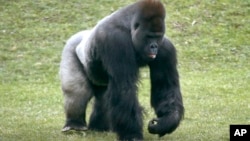One day in 1996, boys from a village in northern Gabon brought home a chimpanzee they found dead in the forest. The villagers butchered it for food.
That act set off an Ebola outbreak that killed 21 people, according to the World Health Organization.
Years later, on a reporting trip in Gabon, author David Quammen met two men from the village who were there during the outbreak.
At the time Ebola was ravaging their village and their families, they noticed something strange. In the forest nearby, 13 gorillas lay dead.
Thirteen dead gorillas, 21 dead humans. Plus the chimpanzee the boys found in the forest.
All victims of Ebola.
'Wave of death'
For the western lowland gorilla, the toll of Ebola has been devastating.
“There has been an epidemic wave of death passing through gorilla populations across central Africa,” Quammen said, “a wave of Ebola killing them as well as occasionally killing humans.”
Ecologist Peter Walsh with the University of Cambridge watched 90 to 95 percent of the gorillas he was studying in a Congolese sanctuary disappear in two Ebola outbreaks in the early 2000s.
He co-authored a scientific assessment that put the western lowland gorilla on the critically endangered list in 2007.
“The combination of bushmeat hunting and disease was really slamming western gorillas,” he said.
Walsh and his colleagues estimated that Ebola would wipe out 45 percent of the entire population in just one generation.
Connectedness
For Quammen, the villagers’ story of the 13 dead gorillas stuck with him. It demonstrated “the connectedness between other species and humans when it comes to these new, emerging viruses,” he said.
Quammen went on to author Spillover: Animal Infections and the Next Human Pandemic. In the book, he describes the growing pace at which diseases are spilling over from animals to people.
“It’s not a new thing. It’s been around for a long time,” Quammen said. Bubonic plague jumped from rodents to humans through infected fleas and killed as much as 60 percent of Europe in the 14th century.
And Ebola is not the first species to spill over from apes.
The most lethal species of malaria, Plasmodium falciparum, came from gorillas, according to research Walsh co-authored.
Into the woods
But the pace of spillover seems to be increasing, Quammen said.
“Something seems to be different because we’ve seen a lot of these new diseases, especially viral diseases, emerging over the last five or six decades. And that, of course, raises the question of, why?”
One answer, Quammen said, is the growing human population that is encroaching deeper and deeper into new habitats.
“There are now 7 billion of us on the planet. We’re going into these diverse ecosystems. We’re cutting down trees, we’re building mines and roads.”
And as humans encounter the animals living in these ecosystems, he added, “We’re giving the viruses those animals carry the opportunity to jump to a new host.”
William Karesh, an infectious disease expert at EcoHealth Alliance, said, “It’s becoming very clear that there’s a strong correlation between environmental change of any type and disease emergence.
“Whether it’s deforestation or agricultural growth or reforestation, it’s that change that allows that disease to emerge because it’s disrupting the natural balance," Karesh said.
Spilling back
Spillover goes in the other direction, too.
Ecotourism has been great for protecting wild-ape habitat, ecologist Walsh said. But “in the places where we’re succeeding the most in protecting them from hunting and habitat loss," he noted, "we’re killing them with our viruses.”
Human respiratory viruses are the No. 1 killer of chimpanzees and gorillas that are accustomed to the presence of humans. In chimpanzees, half of the deaths are caused by human respiratory viruses.
Walsh advocates vaccinating apes that come in contact with tourists against human diseases such as measles.
He and his colleagues call for better enforcement of the laws against hunting the critically endangered western lowland gorilla, and better protection of their dwindling habitat.








